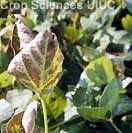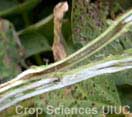Brown Stem Rot (BSR)


Symptoms:
- The key symptoms are browning of the vascular system and often there is brown and yellow discoloration between the leaf veins.
- If stems are split the stems late in the season, healthy stems have white pith tissue, while infected tissue is dark brown.
- The browning may only occur at the nodes or lower stem.
- Leaves may turn brown and dry while remaining attached to the stem, although the leaf symptoms may or may not develop depending on cultivar and environment.
- The leaf symptoms can be confused with those of SDS, but the two diseases can be differentiated by internal stem symptoms.
Pathogen Involved:
- Phialophora gregata (a fungus).
- This pathogen overwinters in soybean stem residue and in soil.
- Two genotypes are recognized that may cause different symptoms on different soybean varieties.
- Brown stem rot is widespread in the Midwestern states. It is most common in northern areas.
Time of Occurrence:
- The fungus infects through the roots and stem early in the growing season, but symptoms do not appear until 10 to 30 days before harvest.
- The disease is most severe when the weather is cool when the pods are filling.
Conditions Favoring Disease:
- Cool, wet weather during pod-fill, followed by hot, dry weather.
Disease Management: